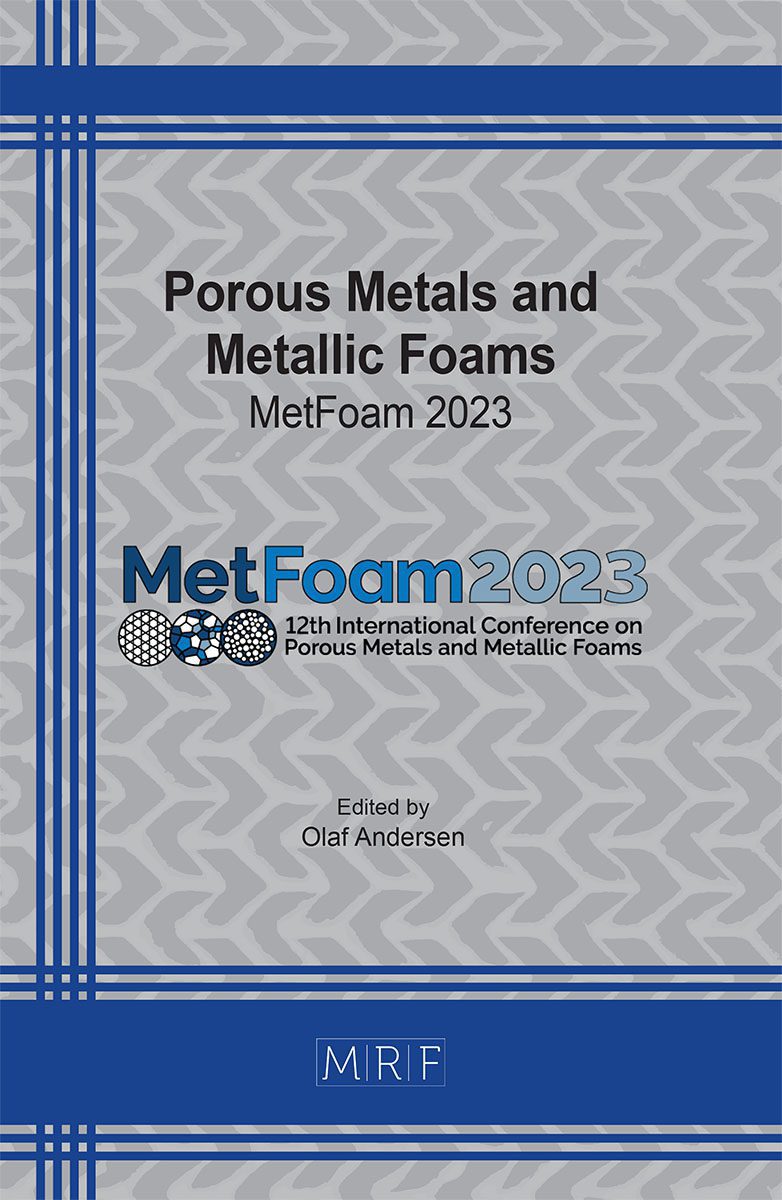Thermal Conductivity of Steel-Steel Composite Metal Foam through Computational Modeling
Zubin Chacko, Afsaneh Rabiei
download PDFAbstract. Thermal capabilities of Steel-Steel composite metal foam (CMF) against extremely high temperatures using computational methods have been investigated and contrasted with the characteristics of the base bulk steel materials. A physics-based three-dimensional model of CMF was constructed using Finite Element Analysis software for analyzing its thermal conductivity. The model built and analyzed in ANSYS Fluent was based on high temperature guarded-comparative longitudinal heat flow technique. ANSYS Fluent allows for the inclusion of air in the model, which is the main contributor to the low thermal conductivity of CMF compared to its constituent material. The model’s viability was checked by comparing the computational and experimental results, which indicated approximately 2% deviation throughout the investigated temperature range. Excellent agreement between the experimental and computational model results shows that the CMF can be first modeled and analyzed using the proposed computational technique for the desired thermal insulation application before manufacturing. Based on the ratios of the matrix to the spheres and the thickness of the sphere walls, CMF can be tailored to the density requirements and then checked for its thermal performance using the model, thereby lowering the cost involved in its manufacturing and thermal characterization experiments.
Keywords
Composite Metal Foams, Effective Thermal Diffusivity, Effective Thermal Conductivity, Computational Modeling, ANSYS Fluent, Thermal Insulation
Published online 2/25/2024, 8 pages
Copyright © 2024 by the author(s)
Published under license by Materials Research Forum LLC., Millersville PA, USA
Citation: Zubin Chacko, Afsaneh Rabiei, Thermal Conductivity of Steel-Steel Composite Metal Foam through Computational Modeling, Materials Research Proceedings, Vol. 39, pp 17-24, 2024
DOI: https://doi.org/10.21741/9781644903094-3
The article was published as article 3 of the book Porous Metals and Metallic Foams
![]() Content from this work may be used under the terms of the Creative Commons Attribution 3.0 license. Any further distribution of this work must maintain attribution to the author(s) and the title of the work, journal citation and DOI.
Content from this work may be used under the terms of the Creative Commons Attribution 3.0 license. Any further distribution of this work must maintain attribution to the author(s) and the title of the work, journal citation and DOI.
References
[1] L. J. Vendra and A. Rabiei, “A study on aluminum–steel composite metal foam processed by casting,” Materials Science and Engineering: A, vol. 465, no. 1–2, pp. 59–67, Sep. 2007. https://doi.org/10.1016/j.msea.2007.04.037
[2] B. P. Neville and A. Rabiei, “Composite metal foams processed through powder metallurgy,” Mater Des, vol. 29, no. 2, 2008. https://doi.org/10.1016/j.matdes.2007.01.026
[3] W. H. Hsieh, J. Y. Wu, W. H. Shih, and W. C. Chiu, “Experimental investigation of heat-transfer characteristics of aluminum-foam heat sinks,” Int J Heat Mass Transf, vol. 47, no. 23, pp. 5149–5157, Nov. 2004. https://doi.org/10.1016/j.ijheatmasstransfer.2004.04.037
[4] S. Chen, J. Marx, and A. Rabiei, “Experimental and computational studies on the thermal behavior and fire-retardant properties of composite metal foams,” International Journal of Thermal Sciences, vol. 106, pp. 70–79, Aug. 2016. https://doi.org/10.1016/j.ijthermalsci.2016.03.005
[5] A. Rabiei and M. Garcia-Avila, “Effect of various parameters on properties of composite steel foams under variety of loading rates,” Materials Science and Engineering: A, vol. 564, pp. 539–547, Mar. 2013. https://doi.org/10.1016/j.msea.2012.11.108
[6] C. S. Kim, “Thermophysical properties of stainless steels,” 1975.
[7] B. Banerjee, An evaluation of plastic flow stress models for the simulation of high-temperature and high-strain-rate deformation of metals. 2005.
[8] J. G. Hust and A. B. Lankford, “Thermal conductivity of aluminum, copper, iron, and tungsten for temperatures from 1 K to the melting point,” Jun. 1984.
[9] Y. A. Çengel, Heat Transfer: A Practical Approach. McGraw-Hill, 2003.
[10] A. Eucken, “Allgemeine Gesetzmäßigkeiten für das Wärmeleitvermögen verschiedener Stoffarten und Aggregatzustände,” Forschung auf dem Gebiete des Ingenieurwesens, vol. 11, no. 1, pp. 6–20, Jan. 1940. https://doi.org/10.1007/BF02584103
[11] M. F. Ashby, A. Evans, N. A. Fleck, L. J. Gibson, J. W. Hutchinson, and H. N. G. Wadley, “Metal foams: a design guide,” Mater Des, vol. 23, no. 1, p. 119, Feb. 2002. https://doi.org/10.1016/S0261-3069(01)00049-8
[12] “Standard Test Method for Thermal Conductivity of Solids by Means of the Guarded-Comparative-Longitudinal Heat Flow Technique 1”. https://doi.org/10.1520/E1225-04.
[13] X.-H. An, J.-H. Cheng, H.-Q. Yin, L.-D. Xie, and P. Zhang, “Thermal conductivity of high temperature fluoride molten salt determined by laser flash technique,” Int J Heat Mass Transf, vol. 90, pp. 872–877, Nov. 2015. https://doi.org/10.1016/j.ijheatmasstransfer.2015.07.042
[14] A. Rabiei, N. Amoafo-Yeboah, E. Huseboe, and C. Scemama, “A Study on Thermal Properties of Composite Metal Foams for Applications in Tank Cars Carrying Hazardous Materials,” in Minerals, Metals and Materials Series, 2022. doi: 10.1007/978-3-030-92567-3_23
[15] A. N. Abramenko, A. S. Kalinichenko, Y. Burtser, V. A. Kalinichenko, S. A. Tanaeva, and I. P. Vasilenko, “Determination of the thermal conductivity of foam aluminum,” Journal of Engineering Physics and Thermophysics, vol. 72, no. 3, pp. 369–373, May 1999. https://doi.org/10.1007/BF02699196
[16] S. Min, J. Blumm, and A. Lindemann, “A new laser flash system for measurement of the thermophysical properties,” Thermochim Acta, vol. 455, no. 1–2, pp. 46–49, Apr. 2007. https://doi.org/10.1016/j.tca.2006.11.026































